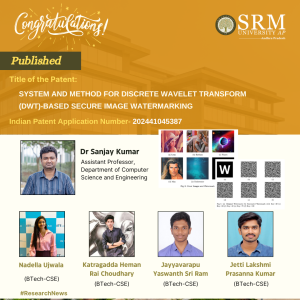 In a recent development, Dr Sanjay Kumar, Assistant Professor in the Department of Computer Science and Engineering, along with a team comprising N Ujwala, J Yashwanth Sri Ram, J Lakshmi Prasanna Kumar, and K Heman Rai Choudhary, have successfully filed and published an innovative invention in the Patent Office Journal titled “SYSTEM AND METHOD FOR DISCRETE WAVELET TRANSFORM (DWT)-BASED SECURE IMAGE WATERMARKING” with the application number “202441045387”.
In a recent development, Dr Sanjay Kumar, Assistant Professor in the Department of Computer Science and Engineering, along with a team comprising N Ujwala, J Yashwanth Sri Ram, J Lakshmi Prasanna Kumar, and K Heman Rai Choudhary, have successfully filed and published an innovative invention in the Patent Office Journal titled “SYSTEM AND METHOD FOR DISCRETE WAVELET TRANSFORM (DWT)-BASED SECURE IMAGE WATERMARKING” with the application number “202441045387”.
This invention holds great promise in the field of digital image security and watermarking. The patented system and method are based on the discrete wavelet transform (DWT), a widely used signal processing technique, to embed secure watermarks into digital images. The application of DWT ensures that the watermarking process is robust and secure, making it suitable for a wide range of applications where image integrity and authenticity need to be ensured.
Dr Sanjay Kumar’s expertise as an Assistant Professor, coupled with the team’s skills and dedication, has resulted in the successful development and patenting of this cutting-edge technology. The “SYSTEM AND METHOD FOR DISCRETE WAVELET TRANSFORM (DWT)-BASED SECURE IMAGE WATERMARKING” promises to be a significant addition to the field of digital image security and watermarking, offering enhanced protection against unauthorised tampering and misuse of digital images. It is expected that this invention will garner attention from industry professionals, researchers, and policymakers, paving the way for its integration into diverse digital imaging systems.
Abstract
Our research introduces a robust image watermarking technique that combines Discrete Wavelet Transform (DWT) and chaotic map-based encryption. The method analyzes high-frequency sub-bands derived from DWT applied to the blue channel of an RGB image, selecting the block with the highest energy for embedding a grayscale watermark encrypted with the Henon Map. The alpha blending technique is used to integrate the encrypted watermark, ensuring both imperceptibility and robustness. The method achieves an average PSNR of 43.7211 dB and SSIM of 0.9950. The watermark can be extracted by analyzing patterns in the high-frequency component, even after various attacks, using inverse DWT and Henon Map for decryption.
Explanation of the Patent in Layperson’s Terms
Our research focuses on protecting digital images by embedding a hidden watermark that is hard to remove. We use a mathematical method called the Discrete Wavelet Transform (DWT) to break down an image into different parts and find the best place to hide the watermark. The watermark is further secured by encrypting it with a technique called the Henon Map. Our method ensures that the watermark remains invisible to the naked eye while being resistant to tampering. This means the watermark can be detected and recovered even if the image is altered.
Practical Implementation and the Social Implications
The primary application of our research is in protecting the ownership and integrity of digital images. This technique can be used by photographers, artists, and digital content creators to ensure their work is not copied or altered without permission. By embedding a secure, invisible watermark, they can prove ownership and detect unauthorised use. Additionally, this method can be applied in sensitive fields such as medical imaging and legal documents where tamper detection is crucial.
Collaborations
This research was conducted by the Visual Information Processing Lab at the Department of Computer Science and Engineering, SRM University AP, Guntur, India. The team comprised Nadella Ujwala, Sanjay Kumar, Jayyavarapu Yaswanth Sri Ram, Jetti Lakshmi Prasanna Kumar, and Katragadda Heman Rai Choudhary.
Future Research Plans
Our future research will focus on enhancing the watermarking technique’s robustness against more sophisticated attacks, exploring real-time applications in video watermarking, and developing methods to embed multiple watermarks in a single image. We also aim to reduce the computational complexity to make the algorithm more efficient for practical applications.

